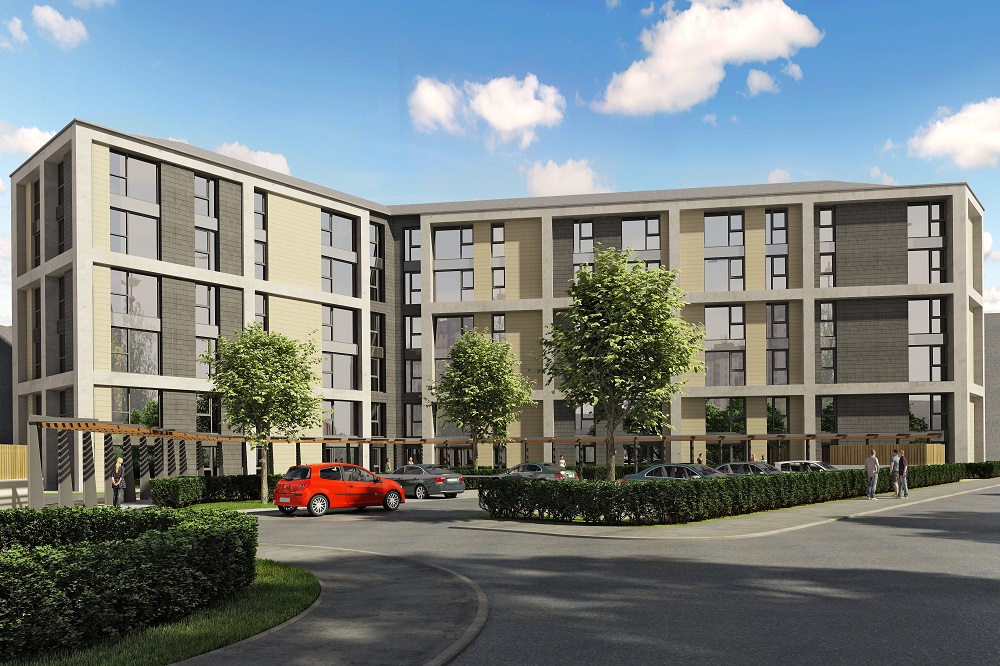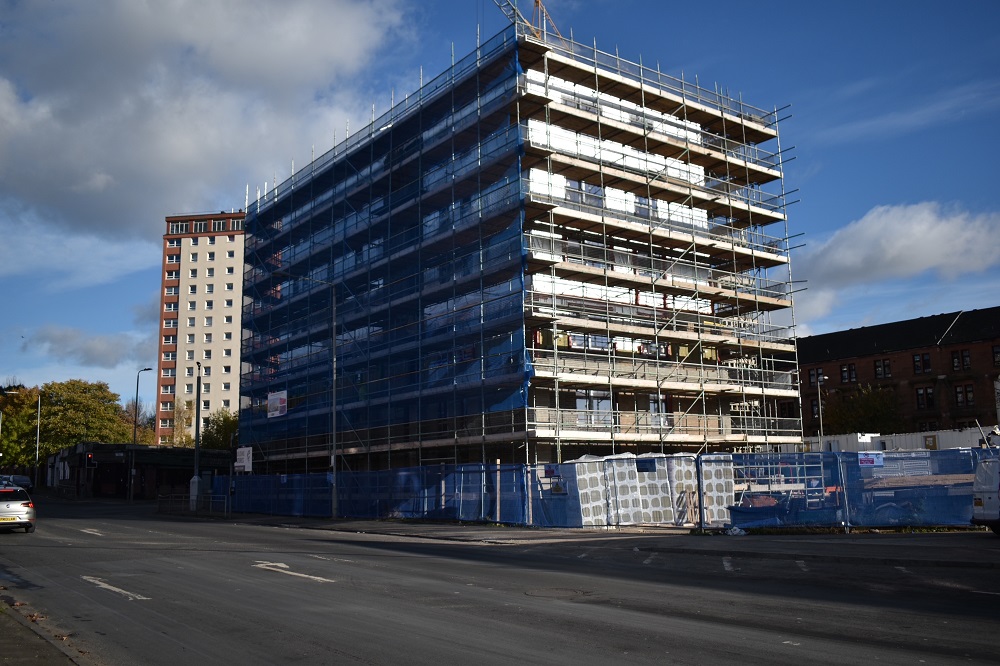West of Scotland Housing Association makes progress on Glasgow’s largest Passivhaus development
The next project to feature in our COP26SCN feature on how the housing sector is playing its part to tackle climate change is West of Scotland Housing Association’s (WSHA) landmark Passivhaus social housing development in Glasgow’s East End.

The Springfield Cross development is due for completion in summer 2022 and will be the largest of its kind in Glasgow. It will comprise 36 flats over six storeys and be created to meet Passivhaus Standard which reduces the building’s carbon footprint and contributes towards the Scottish Government’s Climate Change (Scotland) Act 2009 target to reduce carbon emissions by 2050.
The new homes will be an attractive and modern addition to the housing mix in the east end and brings back into use a brownfield site. The development occupies a prominent corner on London Road and Springfield Road on the edge of the Commonwealth Village in the shadow of Celtic Park and the Emirates Arena.
These ultra-low energy buildings require little energy use for heating or cooling which means low fuel bills for tenants and this, in turn, will help address fuel poverty. The properties will benefit from innovative techniques such as additional insulation, triple glazed windows, gas boiler mainly to heat hot water and a mechanical ventilation & heat recovery system that will provide low running costs for tenants and deliver health benefits through constant clean air being circulated. This is important given the development’s proximity to a busy main road. A communal Wi-Fi system is also proposed to promote digital inclusion.

WSHA is planning to conduct pre and post occupation surveys to assess and compare the buildings performance and the impact on tenants’ behaviour in terms of energy consumption. The surveys will also give tenants to share their experience living in a Passivhaus and operating the new technologies as well as any health or financial benefits as a result.
As a development partner of hub West Scotland, the project was procured through their pre-procured Contractors Framework and CCG (Scotland) Ltd was appointed as the preferred developer. Funded by a £4.3 million of grant from Glasgow City Council’s Affordable Housing Supply Programme and WSHA’s private finance.

Andrew Kubski, director of development and asset management, WSHA, added: “We are delighted to be making steady progress to deliver Glasgow’s largest Passivhaus development. These new Passivhaus homes will be created to achieve one of the highest standards of energy efficiency which will lead to lower fuel bills for tenants and help to address fuel poverty.
“With the eyes of the world on Scotland as it hosts COP26, it is the perfect time to reflect on how the housing sector can play a part in tackling climate change and creating greener communities. Our Passivhaus developments are a key part of our Green Strategy which highlights how we will achieve a greener and more sustainable future in the coming years.”
The delivery of the Passivhaus homes is part of WSHA’s Green Strategy which outlines its commitment to playing its part in tackling climate change. WSHA has committed that at least 40% of its current new-build development programme will be built to Passivhaus standard. WSHA will soon start on site at Scotland’s largest Passivhaus development at Dundashill, Glasgow. The 90 affordable homes will also be Scotland’s first mid market rent Passivhaus.

CCG managing director, David Wylie, said: “Springfield Cross is being constructed using CCG’s specially-designed ‘iQ’ Timber System which is also integrated with our enhanced window and door sets; products that are each manufactured just 2.5 miles from the development.
“We utilise an ‘off-site manufacturing’ process to combine these products together with components such as internal wall linings and insulation to complete entire wall zones before being transported to site. Through this process, which is extremely low-waste, uses responsibly-sourced timber and requires fewer vehicle movements, we are helping to lower carbon emissions at each stage of build. This is known as embodied carbon and when combined with the significant reduction in operational carbon emissions attributed to Passivhaus, we are ultimately reducing the carbon footprint of the development for the entirety of its lifespan.”

Project architect and senior partner of Robert Potter & Partners’, Jonathan Potter, said: “Designing to meet Certified Passivhaus standard provides easy-to-heat, comfortable houses for residents as there are no draughts or cold bridges. Each flat only needs a heated towel rail and a small radiator as the heat gains from residents, fridge, TV are all captured and recycled.
“Passivhaus also means efficient ventilation, good indoor air quality, even temperatures, and triple glazing for quieter homes. The independent Certification supports high quality workmanship, and ensures the building performance meets the design predictions. Springfield Cross also meets The Glasgow Standard of space and flexibility for residents.”
Hub West Scotland CEO, Iain Marley, added: “Springfield Cross will offer very energy efficient and high quality accommodation to tenants in the East End of Glasgow. This leading edge development provides 36 one and two bedroom flats that are built to Passivhaus specifications – as such it will make a significant contribution to addressing fuel poverty and meeting net zero emissions targets.”
All the COP26SCN articles will be available to view here. New contributions are still welcome and feel free to join in the conversation on social media using #COP26SCN.




















